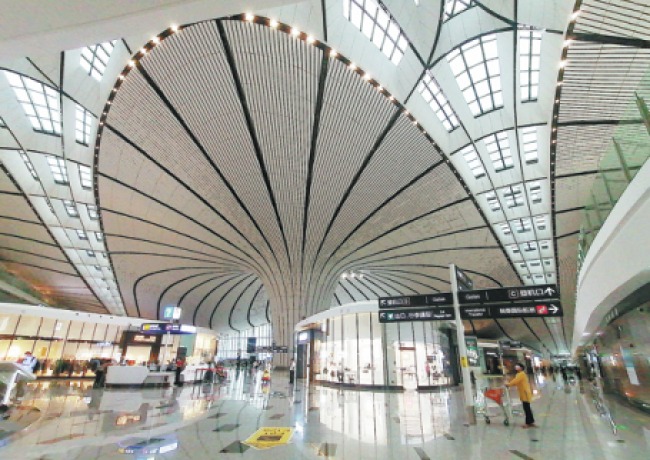Daxing intl airport a leader in green development

Beijing Daxing International Airport makes the best of natural light and ventilation to reduce carbon emissions. [Photo by Du Jianpo for China Daily]
Beijing Daxing International Airport integrates state-of-the-art technologies with eco-friendly development, serving as a pioneer in the construction of China's green and low-carbon airports and contributing a China solution to the sustainable growth of the global aviation sector.
The airport, located in Daxing district on the southern outskirts of Beijing, began operations in September 2019, after four years of construction.
With green concepts running through the buildings, along with the energy, environment, transportation and operation mechanisms, the airport has adopted a variety of innovative technologies while featuring environmentally friendly projects.
Green buildings dominate the airport, with more than 70 percent rated as top-level green buildings in China, industry insiders said.
Using an optimized, integrated energy-saving design, its passenger terminal makes the best use of natural light and ventilation, with more than 60 percent of the terminal's indoor area relying on natural light as a source of illumination. That helps to cut energy consumption, a 30 percent improvement from the national energy conservation standards for public buildings, and reduces carbon dioxide emissions by 22,000 metric tons a year.
The use of renewable energy is another highlight of the airport's green operations. Through a ground source heat pump system, photovoltaic power and other means, renewable energy contributes more than 16 percent of the airport's energy supply.
The stable GSHP system is capable of meeting the heating and refrigeration needs for 2.57 million square meters of surrounding buildings, reducing carbon dioxide emissions by 30,000 tons a year.
Solar panel systems installed in the airport, with a combined installation capacity of over 10 megawatts, can save the energy equivalent of 1,900 tons of standard coal on a yearly basis.
The airport is an active player in the trade in green power, bringing in clean energy such as hydropower, wind and solar power supplied from Qinghai and Shanxi provinces as well as other regions.
The airport also stands out among its peers at home and abroad in the use of new energy vehicles.
More than 1,500 NEVs are in service at Daxing airport, accounting for 77 percent of the total vehicles serving the airport. To ensure their smooth operation, the airport has been equipped with more than 500 charging piles. Since the airport opened its doors, the NEVs have run 14.5 million km and been put on charge more than 1.01 million times, cutting down consumption of gasoline and diesel by roughly 2,098 tons.
A key part of Beijing's sponge city construction, the Daxing airport values the full-process treatment of rainwater, ranging from filtration, storage and purification to utilization and disposal, becoming a veritable sponge airport.
As an eco-friendly development practitioner, it operates the country's first airport environment information management system. By collecting environmental information on noise, air quality, surface water quality and solid waste, the system can provide an overview of the airport's environmental situation, predict changes in environmental quality and realize the comprehensive environmental management of its surroundings through big data analysis.

